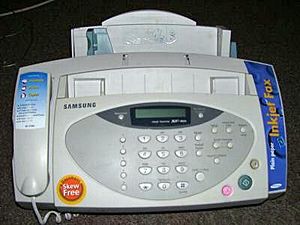Fax facts for kids
A fax machine is a special device that sends copies of documents, like papers with text or pictures, using a telephone line. It's a bit like sending a picture of a paper from one place to another! The word "fax" is short for "facsimile," which means an exact copy.
When you send a fax, your machine scans the document. This turns the words and images into a digital picture called a bitmap. This digital picture is then sent through the phone system. On the other end, the receiving fax machine gets this coded picture and prints it out on paper.
Many businesses still use fax systems. Even though we have the Internet, faxes can be useful. For example, they are sometimes used for sending important documents that need to be very secure. While internet messages can be made secure with encryption (a secret coding system), some people prefer faxes for certain things.
In some countries, a signature sent by fax is legally accepted on contracts. This is not always true for electronic signatures sent over the internet. This is another reason why fax machines are still used in business.
Many offices now use "fax servers" instead of separate fax machines. These servers receive faxes electronically and can send them to people's computers or secure emails. This helps save paper and can reduce phone line costs for businesses.
Contents
How Fax Machines Work
Sending a Document
When you put a document into a fax machine to send it, the machine first scans it. Imagine a scanner taking a picture of your paper. This picture is turned into tiny dots, like pixels on a screen. This digital image is called a bitmap.
Sending Over Phone Lines
Once the document is a digital image, the fax machine turns these dots into sounds. These sounds are then sent through a regular telephone line, just like when you make a phone call. The sounds travel to the fax machine at the other end.
Receiving and Printing
The fax machine on the other side hears these sounds. It then turns the sounds back into the digital image of dots. Finally, it prints this image onto a piece of paper. So, the person receiving the fax gets an exact copy of your original document!
The History of Fax Technology
Early Inventions
The idea of sending pictures over wires is quite old! A Scottish inventor named Alexander Bain worked on early fax-like devices. In 1843, he received the first patent for a fax machine. He could reproduce graphic signs in his lab by 1846. Later, Frederick Bakewell improved Bain's design and showed off his own telefax machine.
An Italian scientist named Giovanni Caselli invented the Pantelegraph. This was the first commercial telefax service. It started between Paris and Lyons in 1865. This was actually 11 years before the telephone was invented!
Scanning and Radio Faxes
In 1881, an English inventor named Shelford Bidwell built the scanning phototelegraph. This was the first fax machine that could scan any flat original document. You didn't have to draw or plot it by hand. Around 1900, German physicist Arthur Korn invented the Bildtelegraph. This machine became very popular in Europe. In 1908, a photograph of a wanted person was sent from Paris to London using it.
Later, faxes started being sent by radio waves instead of landlines. From the 1960s, they could even be sent by satellite. Today, most fax systems use digital technology. Modern fax machines are faster, more efficient, and cheaper. This has made it possible for even small companies to own one. Fax technology is now used all over the world.
Images for kids
-
A fax machine from 1999 employing inkjet printing, which was modern for fax machines at that time.
-
Laser fax having a compact, built-in laser printer, 2001.
-
The chip in a fax machine. Only about one quarter of the length is shown. The thin line in the middle consists of photosensitive pixels. The read-out circuit is at left.
See also
 In Spanish: Fax para niños
In Spanish: Fax para niños










